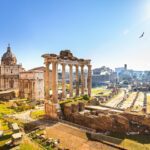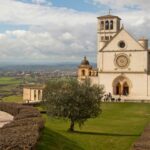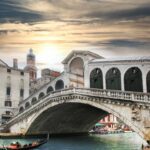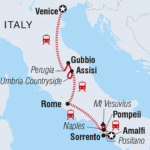Italy Uncovered
From the canals of Venice to ancient Rome to the glittering beachside oasis of the Amalfi Coast, you’ll see all the best bits on this Italian adventure. You’ll discover history and sacred sites, tuck into some of the most delectable Italian cuisine and enjoy sweeping views across the diverse landscapes. From taking a cable car 1,000 metres above the Umbrian countryside, to mingling with the locals during a farmstay in the hills, to soaking in that toasty Italian sun in Positano, this 15-day journey packs a punch. Encounter the religious, historical and natural treasures of one of the most alluring regions in Europe on this delightful Italian adventure.
15 days, from
$6,170
per person
GROUP SIZE
ACTIVITY LEVEL
Details
Countries Visited:
Italy
Accommodation: Hotel (13 nights), Farm Stay (1 night)
Transportation: Train , Public bus , Metro , Cable car , Boat , Private Vehicle
Included Meals:
- 12 breakfasts
- 1 lunches
- 1 dinners
Group size: Minimum 1, Max 12
Minimum Age: 15
Explore the quintessential medieval town of Gubbio, one of the oldest towns in the region, it’ll be like stepping back in time as you wander the cobblestone streets and marvel at gothic palaces.
Unwind in the Italian countryside during a farm stay, where you’ll hike through vineyards and enjoy rolling vistas before enjoying a wine tasting followed by dinner prepared with ingredients fresh from the farm.
Feel La Dolce Vita while sipping espresso alongside sharp-dressed locals on the glamorous Sorrentine Peninsula.
Explore the vast, frozen in time ruins of ancient Pompeii, which emerged from the ashes after thousands of years, and take a peak inside the steaming crater of Mt Vesuvius, the volcano that destroyed it
Hike among the olive groves on the Path of the Gods along the spectacular Amalfi Coast
Itinerary
Buongiorno! Welcome to Venice – the waterside wonderland of bridges, towers, piazzas, canals, churches and gondolas – all practically unchanged for 600 years. Our adventure officially kicks off with a Welcome Meeting this evening, if you arrive early there are plenty of things to keep you busy. You might like to take a walk around the maze of streets behind San Marco Square and get acquainted with the complex canal system of Venice. The Grand Canal is a great place to start, as you can stroll over the Rialto Bridge and browse the endless amounts of boutique shops that sell Venetian masks and handmade Murano glassware. After this evening’s Welcome Meeting, why not enjoy dinner with your fellow travel companions at a local restaurant.
You’ll be up bright and early for a train journey to Perugia this morning. Enjoy a walking tour of this city with your leader to discover the cobblestone alleyways leading to a medieval center, gothic mansions and archways that give a glimpse into Perugia’s past. After some time to explore and stretch your legs, you’ll continue to Gubbio on a local bus where you’ll get a chance to rub shoulders with the locals. The streets of Gubbio, the province’s oldest town, are filled with stone houses and orange-tiled roofs, set against a mountain backdrop. A quintessential medieval town, there are centuries of history around every corner and the right amount of requisite cobblestone streets, gothic palaces and churches. The surrounding countryside is also lush and cool – the reason why many Italians retreat here in the summer months. When you arrive in the late afternoon, a good way to get to know the town is to simply wander the 14th and 15th century streets. And a trip to Gubbio wouldn’t be complete without a lengthy lunch or dinner along one of its narrow streets, so grab an outdoor table at a taverna for truffle-infused delight to the senses.
This morning, take a ride in Gubbio's unique cable car – a 15-minute and 1,000-metre-high ride to the Basilica of Sant'Ubaldo, which contains the mummified body of the town's patron saint. From here, you can marvel at the amazing vistas of the Umbrian valleys and mountains, plus get a great rooftop view of the town itself. You'll then have some free time to explore the delights of Gubbio as you wish. You might like to take in the Civic Museum (home to 3rd-5th century BC bronze Eugubine Tablets), the Duomo, or the Palazzo Ducale, whose original wooden study was deemed so exceptional it was shipped off to New York’s Metropolitan Museum of Art. Explore the many churches around town, including one where legend has it, St Francis tamed a wolf that was terrorising the town. Otherwise, simply just relax into the Umbrian pace of life. Enjoy a variety of local cuisine and try one of the dishes that Umbria is famous for – pecorino cheese, game meat and mushrooms all feature on restaurant menus.
After breakfast this morning, we’ll continue to Assisi, Italy's second-holiest city. Assisi was the home of one of the world's most famous saints and the founder of the Franciscan order – St Francis. Join your group leader on an orientation walk to uncover a plethora of impressive monuments in Assisi, including Piazza Matteotti, the Basilica of St Clare and the Roman temple remains. Plus, take a short, guided tour of the magnificent Basilica di San Francesco (St Francis Cathedral). Construction of the basilica started the day after St Francis's canonisation in 1228, and this imposing building houses the bones of St Francis and four of his followers. With some free time this afternoon, you could walk the small trail to the top of Monte Subasio, home to the Eremodelle Carceri, a hermitage where Francis came to pray. Then tonight, satisfy your appetite with all the pasta you can eat.
Today is all yours to explore this beautiful region as you wish. You may choose to take the train to the charming nearby medieval town of Spello (approximately 20 minutes), a Roman town that straddles a thin ridge at the base of Mount Subasio – the mountain where St Francis was said to have talked to the animals. It’s a place scattered with weathered Roman monuments and known for its wine and rural charm. Two of the local churches feature frescoes by famed Renaissance painter Pinturicchio, who later lent his hand to works in the Vatican and Siena’s cathedral. Be sure to sample exclusive local wine and regional food specialties while you’re here. Or simply explore the back streets of Assisi – walk the via Guila that circles town, and stop by Piazza Santa Chiara – which has a stunning panorama of the Umbrian countryside – and Piazza del Comune, which gives an insight into life here in Roman times. It’ll be very hard not to spend the whole evening simply continuing the day’s foodie theme and indulge on the region’s fabulous food.
This morning, you’ll travel through the countryside to your special farm stay accommodation nestled in the Umbrian hills. Along the way, you’ll stop at Bevagna’ Sculpture Park and enjoy a rewarding hike through the castles and countryside. You’ll walk through vineyards and olive groves and get spectacular views of the ancient castles here. After some time to stretch your legs and take in the rolling vistas, you’ll kick back with a little lunch and wine tasting – what better way to finish a hike? From here, you’ll continue to your farm stay accommodation. The afternoon is at your leisure to relax, maybe hang by the pool and soak in the tranquil atmosphere of your farm resort. This evening, sit down to a special dinner prepared by your hosts using ingredients grown on the farm – it doesn’t get much fresher than that!
Travel back to Assisi this morning and hop on a train to Rome in the afternoon. Remember while you’re here, the best attitude is ‘when in Rome’! Join your leader on an orientation walk around the city, where you’ll see some of the iconic sights such as the Colosseum and Arch of Constantine, the Forum (centre of ancient Rome), the Victor Emmanuel Monument, the Pantheon, Spanish Steps, Via Dei Condotti and Piazza Venezia. Rome is packed full of restaurants and trattorias that cater to every taste and budget. Local specialties include pastas such as carbonara (egg, cheese and bacon) and amatriciana (tomato, bacon and chilli). Eating in trattorias will also give you a chance to sample some local Italian wines. Our top tip – try a few of the house wines, they’re usually a delightful (and affordable) drop. Head out in the evening with the group for a final farewell gastronomic fling.
Today is a free day to explore Rome. Crowded with ancient ruins and religious monuments, Rome still pulses to the beat of modern life and is packed with designer shops, restaurants, cafes and exciting nightlife. There are no activities planned before the group meeting at 6pm tonight.
Travel by train to Naples (approximately 3 hours), a raucous city that overflows with passion, tradition and gastronomy. Naples was carved out by many empires of the past and by merchants and pirates from across the world: Romans, Phoenicians, Carthaginians, Venetians, Spaniards, Normans and Africans. Its evocative, historical old centre is a World Heritage-listed area and the famous Spanish Quarter is still one of the most densely populated residential areas in Europe. Take an orientation walk with your leader and walk through the historical center and the Spanish Quarter. Finish your walk with a visit to the statue of the Veiled Christ. This treasured piece of art was carved over 300 years ago. Its sheer beauty and serenity will surely leave you in awe. Naples is the birthplace of the pizza, so why not head to one of the many pizzerias and taste what's truly some of the best that Italy has to offer. Later in the afternoon, board a train to the time capsule of Pompeii, in the shadow of Mt Vesuvius (approximately 1 hour). Your accommodation is perfectly located right near the entrance to the archaeological excavation site.
The small picturesque town of 'modern' Pompeii has a wonderful old town square – the perfect place to while away some time with the locals, drinking true Italian coffee and watching the world go by. Most of today though will be spent exploring the ruins of ancient Pompeii on a guided tour. Until 26 August, 79 AD, Pompeii was a thriving Roman trading centre, where ordinary people went about their everyday business, but it was frozen in time when Mount Vesuvius erupted, killing 2,000 people and their homes under a layer of ash. The city was never rebuilt and largely disappeared from people’s minds until the 18th century, when the ruins were re-discovered. Now you can take an unparalleled look back into the lives of ancient Romans and discover how they lived, worked and interacted 2,000 years ago. The finely preserved ruins include villas, temples, theatres and bustling markets. Walk along the chariot-marked streets, visit the magnificent amphitheatre and the ‘Villa of Mysteries’. You can also visit the Roman Forum and basilica, temples, public baths, and the tiny Odeon created for music recitals. The rest of the day is free, but if the ruins piqued your interest, head to nearby Herculaneum, which also holds a wealth of fossilised archaeological finds.
This morning take a bus up the mighty Mt Vesuvius, where you’ll meet a local volcanology guide. Ascend to the summit of Mt Vesuvius for staggering 360 degree views over the Bay of Naples and into the steaming crater. Although Mt Vesuvius is still considered to be an active volcano, the last eruption was in 1944 and there's no sign of lava. See first-hand the awesome power of the volcano that engulfed the cities of Pompeii and Herculaneum in 79AD. In the afternoon, travel by private vehicle to the picturesque resort town of Sorrento (approximately 1 hour). People have been coming to the peninsula and islands of the Sorrento region for at least 2,000 years, and set invitingly atop dramatic cliffs over sparkling, blue waters, it's easy to see why. There are many options in this small seaside town with its fine piazzas, maze of old streets, sidewalk cafes and glamorous shops. The area is also famous for its lemon groves, producing the famous limoncello liqueur. In the evening head out to try some of the best limoncello on offer in Sorrento.
You have a free day to explore this delightful area and the museums, galleries and piazzas of Sorrento. Perhaps stroll along the marina or cool off in the waters of the local small beaches. They’re not big on sandy beaches here, so swimming Sorrento-style is via wooden or stone bathing platforms beneath the cliffs. Taking a trip to Capri is also a great option, with a hydrofoil taking you across to the island that was once home to the magnificent holiday palaces of the Roman emperors. Capri’s dramatic rocky coastline is pierced by natural grottoes, while in the interior, narrow roads wind through fragrant citrus groves, past villages of flat-roofed white cubist-looking houses with flower-filled gardens, and manicured towns which offer swanky hotels and chic cafes. Here you can take a boat trip to the fairy-tale Blue Grotto (La Grotta Azzurra), where the water shines with an extraordinary blue translucence, a result of refraction of the sunlight outside. Your leader will be of assistance and will have plenty of suggestions of what to do and see today. End the day a very Italian way with a demonstration of Gelato making.
Arrive on the Amalfi Coast after a short journey by private vehicle (approximately 2 hours). The Amalfi peninsula is a land of rocky coasts, cliff-top vistas, azure seas, tiered lemon groves, whitewashed villages clinging to steep cliffs, and bright blue skies. If you're after a relaxing walk with a few cultural highlights, stroll from one side of Amalfi town to the other and pay a visit to the Cattedrale di Sant'Andrea and the Chiostro del Paradiso. If you’re after something more active, perhaps embark on a walk through the Valley of Mills where for centuries paper mills were in operation. Alternatively catch a bus up the Valley of Dragons to reach pretty Ravello. The French novelist André Gide once described this town as being ‘closer to the sky than the seashore’. For centuries, its lofty position and sunny, dry climate has made it an appealing place for writers, artists, musicians and travellers. Ravello also boasts two magnificent villas – the superb 11th Century Villa Rufolo which was once the home of Wagner, and Villa Cimbrone, a sumptuous 19th Century mansion with fabulous gardens and unequalled views over the Gulf of Salerno. Otherwise just laze around on the beaches and in the piazza, gazing back up at the amazingly picturesque part of the world.
Your leader will take you for a half-day hike along the narrow trail of the famous Sentiero Degli Dei (the Walk of the Gods) which, until quite recently, was followed by mules and donkeys as they traversed the dramatic landscape. This path winds its way through unique scenery and boasts unrivalled views along the coast. Walk through forests and fields of wildflowers, olive groves and vineyards, past ancient stone huts and beside sheer walls of granite. Glimpse local farmers tending their crops by hoe and elbow grease, herds of goats feeding beside the trail beside their shepherds, and teams of workmen commuting by mule. The trail ends in picturesque Positano where there will be ample time to explore and maybe take a dip in the sea. Return to Amalfi by ferry which is the perfect way to see the coast from a different perspective. With tonight your last night as a group, it’s a good idea to gather your fellow travellers together and head out for a feast to celebrate the end of this Italian adventure.
There are no activities planned for the final day and you are able to depart the accommodation at any time. As there is so much to do along the Amalfi Coast you may want to consider to extend your stay here. We are happy to book additional accommodation for you, subject to availability. Please enquire at the time of booking.






